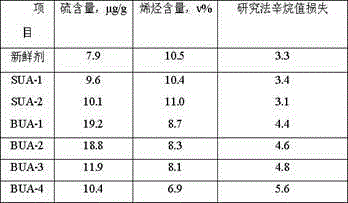Regeneration method for deactivated hydrodesulfurization catalyst
A hydrodesulfurization and catalyst technology, applied in the direction of catalyst regeneration/reactivation, chemical instruments and methods, metal/metal oxide/metal hydroxide catalysts, etc., can solve the problem of reduced catalyst selectivity, high cost, and secondary activation Long processing cycle and other issues to achieve the effect of promoting interaction and redispersion, improving activity and selectivity
- Summary
- Abstract
- Description
- Claims
- Application Information
AI Technical Summary
Problems solved by technology
Method used
Image
Examples
Embodiment 1
[0020] The UA deactivated catalyst was taken, and the catalyst was washed with a citric acid solution with a concentration of 0.5 wt%, and the amount of the pickling solution was 20 L / kg of the catalyst. After drying, impregnate the aqueous solution of KNO3 and ammonium gluconate, requiring K 2 O accounts for 2.0wt% of the total mass of the catalyst; the atomic ratio of ammonium gluconate to Mo is 0.3:1. After drying again, the temperature was raised to 260°C at a rate of 1.5°C / min for 3 hours, and O in the regeneration atmosphere was required 2 The content is 0.5wt%, the rest is N 2 , and then at a rate of 2°C / min, the temperature was raised to 430°C for 5 hours, and the regeneration atmosphere was air. After lowering to room temperature, the product was obtained, number SUA-1
Embodiment 2
[0022] The UA deactivated catalyst was taken, and the catalyst was washed with a tartaric acid solution with a concentration of 1.3 wt%, and the amount of the acid washing solution was 10 L / kg of the catalyst. After drying, impregnated Cu(NO 3 ) 2 And the aqueous solution of ammonium gluconate requires CuO to account for 6wt% of the total mass of the catalyst; the atomic ratio of ammonium gluconate to Mo is 2:1. After drying again, the temperature was raised to 320°C at a rate of 1.5°C / min for 5 hours, and O in the regeneration atmosphere was required 2 The content is 1wt%, the rest is N 2 , and then at a rate of 2°C / min, the temperature was raised to 390°C for 7 hours, and the regeneration atmosphere was O 2 The content is 21wt%. After lowering to room temperature, the product was obtained, number SUA-2
Embodiment 4
[0035] This example is an activity evaluation experiment of the regeneration agent. The experiment was carried out on a 100ml small hydrogenation unit under the conditions of pressure 1.6Mpa, temperature 280°C, hydrogen-oil volume ratio 300, liquid hourly space velocity 3.0h -1 The properties of the raw material oil in the activity evaluation experiment are shown in Table 2, and the evaluation results are shown in Table 3.
[0036] Table 2
[0037]
[0038] table 3
[0039]
[0040] It can be seen from Table 3 that the desulfurization activity and selectivity of the FCC gasoline selective hydrogenation catalyst regenerated by supplementary selective metal additive complexation method and its special regeneration technology are better, and the loss of octane number is reduced .
PUM
 Login to View More
Login to View More Abstract
Description
Claims
Application Information
 Login to View More
Login to View More - R&D
- Intellectual Property
- Life Sciences
- Materials
- Tech Scout
- Unparalleled Data Quality
- Higher Quality Content
- 60% Fewer Hallucinations
Browse by: Latest US Patents, China's latest patents, Technical Efficacy Thesaurus, Application Domain, Technology Topic, Popular Technical Reports.
© 2025 PatSnap. All rights reserved.Legal|Privacy policy|Modern Slavery Act Transparency Statement|Sitemap|About US| Contact US: help@patsnap.com



